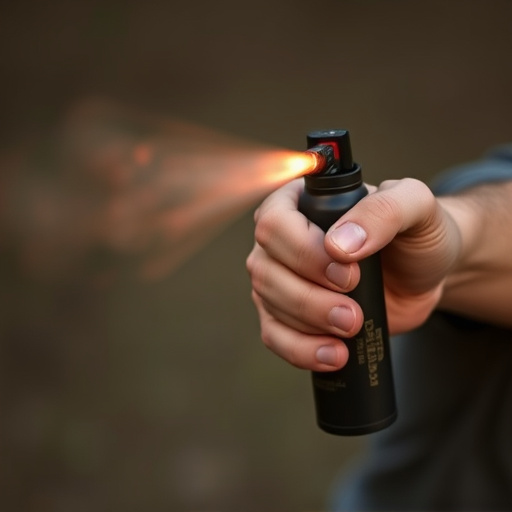Pepper spray is a powerful non-lethal self-defense tool with various types, like oleoresin capsicum (OC) and foam, each having unique strengths. Proper storage in cool, dry conditions away from direct sunlight extends the typical 2-year shelf life. Following manufacturer guidelines for usage frequency and storage ensures optimal performance. Responsible use involves securing storage areas, preventing accidental activation, understanding local laws, aiming at eyes, nose, and mouth at a safe distance, and practicing post-use hygiene. Regular mechanism inspection maintains readiness.
“Uncover the power of civilian defense pepper spray—a vital tool for personal safety. This comprehensive guide explores the essentials of understanding, storing, and utilizing this non-lethal self-defense mechanism effectively. From learning about different pepper spray types to mastering safe storage practices and deciphering shelf lives, we empower users with knowledge. Discover best practices to ensure its reliability when facing potential threats. Get ready to explore the ins and outs of pepper spray, including practical tips on storage and shelf life management.”
- Understanding Pepper Spray: Its Purpose and Types
- Pepper Spray Storage: Tips for Safe Keeping
- Determining Shelf Life: What You Need to Know
- Safety Measures and Best Practices for Civil Defense Pepper Spray Users
Understanding Pepper Spray: Its Purpose and Types
Pepper spray is a non-lethal self-defense tool designed to temporarily incapacitate an attacker, providing users with valuable time to escape or seek help. It works by causing intense irritation and pain in the eyes, nose, and throat, leading to temporary blindness and difficulty breathing. Understanding pepper spray’s purpose is essential for responsible usage and storage.
There are various types of pepper spray available, each with different strengths and applications. These include oleoresin capsicum (OC) spray, which is the most common and potent form, often used by law enforcement. Other types include foam pepper spray and specialized formulas designed for specific purposes, such as extra-range or non-visible (UV) sprays. Proper storage and knowledge of shelf life are crucial for maintaining pepper spray’s effectiveness. Typically, pepper spray should be stored in a cool, dry place away from direct sunlight, heat sources, and incompatible substances like chemicals or metal objects. Following manufacturer guidelines ensures optimal performance and longevity, which can vary depending on factors like usage frequency and storage conditions.
Pepper Spray Storage: Tips for Safe Keeping
Storing pepper spray safely is paramount for ensuring its effectiveness and longevity. Keep it in a cool, dry place away from direct sunlight or extreme heat, as these conditions can degrade the active ingredients. Ideal storage locations include a locked cabinet or a hidden compartment in your home or vehicle, out of reach of children and unauthorized individuals.
When not in use, store pepper spray upright with its safety clip attached to prevent accidental activation. Always check expiration dates for both the spray itself and any replacement parts, such as the nozzle or cartridge. Many modern pepper sprays have a shelf life of up to 3 years, but this can vary based on brand and storage conditions. Regularly inspect your supply, ensuring all products are in good condition before adding new items to your stockpile.
Determining Shelf Life: What You Need to Know
When it comes to civilian defense pepper spray, understanding its shelf life is crucial for ensuring its effectiveness and safety. Unlike food items with clearly labeled expiration dates, pepper spray doesn’t typically have a set “best before” mark. Instead, its shelf life depends on several factors, primarily storage conditions. It’s recommended that pepper spray be stored in a cool, dry place, away from direct sunlight or extreme temperatures. Ideal storage temperature ranges between 50°F to 70°F (10°C to 21°C).
Proper storage can significantly extend the product’s shelf life, which is typically around 3 to 5 years for most brands. However, factors like exposure to moisture or damage during transportation can reduce this lifespan. Always inspect your pepper spray regularly for any signs of damage or changes in consistency, odor, or color before use. If it appears altered, dispose of it safely and consider investing in a new one to maintain optimal performance when you need it most.
Safety Measures and Best Practices for Civil Defense Pepper Spray Users
Using civil defense pepper spray responsibly requires a solid understanding of safety measures and best practices. Always store your pepper spray in a secure, out-of-reach location, especially if children or pets are present. Keep it away from heat sources, direct sunlight, and extreme temperatures to maintain optimal shelf life—typically around 2 years, though this can vary based on the manufacturer’s guidelines. Ensure the container remains sealed to prevent accidental activation and contamination. Familiarize yourself with local laws regarding pepper spray ownership and use, as regulations differ by region.
When using pepper spray, follow instructions carefully. Aim for the eyes, nose, and mouth of the target, but be mindful not to direct it at bystanders or pets. Keep a safe distance, typically 2-3 meters, to minimize cross-contamination. After use, wash your hands thoroughly with soap and water, and consider changing clothing to avoid transferring residue. Regularly inspect the spray mechanism for any signs of damage or blockages, ensuring it’s always ready for use when needed.
In conclusion, pepper spray is a valuable tool for civilian defense, but proper storage and understanding of its shelf life are essential for effectiveness. By following the tips outlined in this article, such as secure storage, regular inspection, and knowledge of expiration dates, users can ensure their pepper spray remains a reliable means of personal protection. Remember, staying informed about your self-defense tools is key to maintaining peace of mind in any situation.
